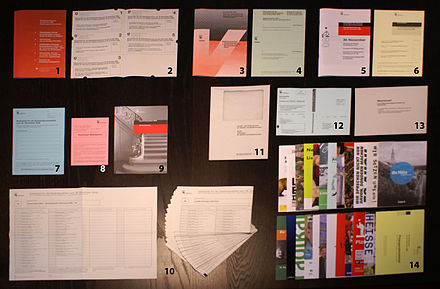Voting
Voting is a method by which a group, such as a meeting or an electorate, can engage for the purpose of making a collective decision or expressing an opinion usually following discussions, debates or election campaigns. Democracies elect holders of high office by voting. Residents of a jurisdiction represented by an elected official are called "constituents," and the constituents who choose to cast a ballot for their chosen candidate are called "voters." There are different systems for collecting votes, but while many of the systems used in decision-making can also be used as electoral systems, any which cater for proportional representation can only be used in elections.
In smaller organizations, voting can occur in many different ways. Formally via ballot to elect others for example within a workplace, to elect members of political associations or to choose roles for others. Informally voting could occur as a spoken agreement or as a verbal gesture like a raised hand or electronically.
In a democracy, the government is elected by the people who vote in an election: a way for an electorate to elect, i.e., choose, among several different candidates.[1] It is more than likely that elections will be between two opposing parties. These two will be the most established and the most popular parties in the country. For example, in the US, the competition is between the Republicans and the Democrats. In an indirect democracy, voting is the method by which the person elected (in charge) represents the people, whilst making decisions. Direct democracy is the complete opposite, the people make the policy decisions directly without selecting a representative to do it for them.
A majority vote is when the mass of individual's vote for the same person. However, whilst each individual's vote does count, a lot of countries use a combination of factors to decide who wins, it is often not just the "popular vote." For example, in the UK the person with the most constituencies wins, but they may not always have the most individual votes (ie, they may have lost the popular vote but still won the election). Many liberal democracies use what is called a secret ballot, hoping to prevent individuals from becoming influenced by other people and to protect their political privacy. The objective for secret ballots is to try to achieve the most authentic outcome. One reasoning behind why this way of voting may capture a better result is mainly related to social influence and peer pressure. People may be obliged to vote for certain parties because of feelings of pressure, siding with what they think may be the majority purely to fit in. Therefore, not only will the people feel more protected with a secret ballot, they may also be able to vote for who they actually think will be the best representative.
Voting often takes place at a polling station but voting can also be done via electronic voting systems, which have been used in India, Brazil, and the Philippines. Voting is voluntary in some countries, like the UK, but it may be compulsory in others, such as Australia.
Because countries have different rules about whether or not voting is compulsory, statistics showing how voting has changed will differ.







